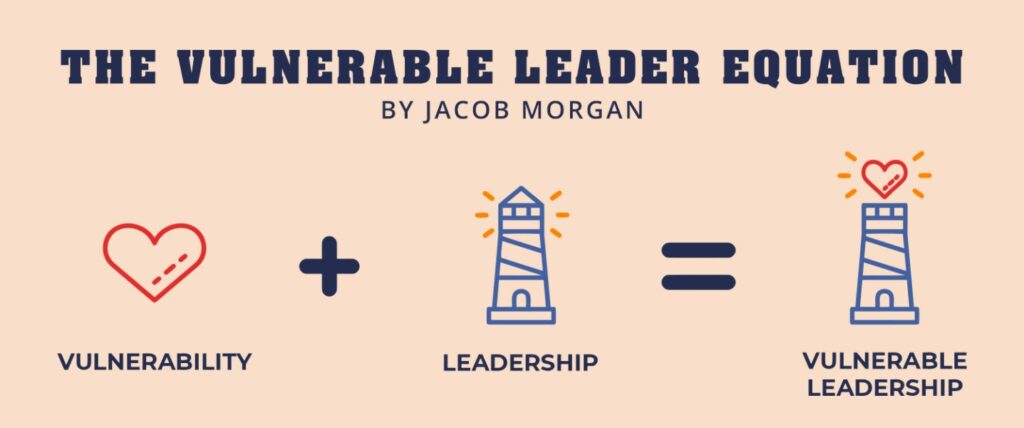I’ll never forget the conversation I had with the CEO of a Fortune 100 company a few years ago. He told me the following.
As a leader at my company I’m expected to be strong, bold, courageous, visionary, competent, and confident. Yet at the same time, my employees want me to be vulnerable and talk about my challenges, struggles, failures, and personal life. How can I reconcile and balance these two seemingly opposing truths?
As I began to work on my new book, Leading With Vulnerability, I realized that this was a very common challenge for many leaders.
Everybody knows what it feels like to be vulnerable but very people know what it means to lead with vulnerability. When most people think of being vulnerable they think of things like sharing a mistake, talking about a challenge, or showing emotion.
It’s true, these are crucial things to do and while these may be valuable in our personal lives is it really just that easy at work where we have a different dynamic at play? What about if you’re in a position of leadership where you are responsible for the lives of others and for the actual dollars and cents that your team or business brings in?
I interviewed over 100 CEOs around the world and surveyed 14,000 employees in partnership with DDI and I can tell you that vulnerability for leaders is not the same as it is for everyone else. In fact, I’ll go one step further and tell you that leaders shouldn’t be vulnerable at work, but they should instead lead with vulnerability…there’s a crucial difference.
On August 20, 1991 Hollis Harris, the then CEO of struggling Continental Airlines, told his 42,000 employees that the company was struggling, he didn’t see a way out, and that employees should pray for the future of the company. The next day he was fired.
What Hollis did was vulnerable, but there was no leadership.
If Hollis was a junior employee who worked in accounting, then those statements would have had minimal impact. Some employees may have taken notice, maybe some would have taken him out to lunch to ask him why he’s having a bad day, and he would have received some words of encouragement and support from his leader and life would have moved on. When you’re a leader the things you say and do carry more weight and have more impact.
This story was told to my by Doug Parker, the former Chairman and CEO of American Airlines.
Contrast this to another similar story that I have in my book.
Fleetwood Grobler is the President & CEO, Sasol Limited, a South African energy and chemical company with over 28,000 employees. He took over as CEO when the company was over $13 billion in debt and about to be repossessed by the banks. Shortly after he took over as CEO the pandemic happened. He too was asked to address his entire workforce but his message was different.
Fleetwood acknowledged that the company was going through a tough time but he told his employees he had a vision of how they were going to turn the business around. He told his employees that he didn’t know exactly how they were going to achieve this vision but that together they could find a solution and rebuild trust in their customers and employees. Fleetwood said that if his people were willing to help him achieve that vision that together they would find a path forward and see success, which is exactly what happened.
Hollis was vulnerable, Fleetwood led with vulnerability. One of the concepts from my book is The Vulnerable Leader Equation, in fact the entire book is build on top of this idea that leaders must bring together vulnerability and leadership – connection with competence.
A vulnerable leader is a leader who intentionally opens themselves up to the potential of emotional harm while taking action (when possible) to create a positive outcome.
As a leader if you show up to work each day asking for help, talking about your mistakes and challenges, and sharing your emotions, then people are going to wonder why you’re in that role.
You must demonstrate that you are either closing the gaps or are doing things to move forward and create progress. For example, admitting to a mistake is vulnerable but there’s no leadership. Instead, admit to the mistake, share what you learned, and what steps you are going to take to make sure the mistake doesn’t happen again in the future. It’s this action piece – the L (leadership) that so many people oftentimes forget.
Simply being vulnerable at work, especially for leaders, can cause far more harm than good. Instead, lead with vulnerability.
Vulnerability creates connection and leadership is about being good at your job. Great leaders but be able to do both.
More to come soon! In the meantime, I hope this will entice you to pre-order my new book, Leading With Vulnerability. If you pre-order a hard copy and email me proof of purchase I’ll send you a preview of the book, an invite to an exclusive webinar I’m hosting, and 5 of the CEO interviews I did (video and audio with GE, American Airlines, Edward Jones, WW, BD).



